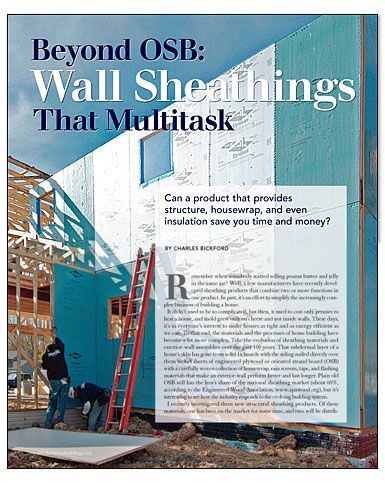Beyond OSB: Wall Sheathings That Multitask
Can a product that provides structure, housewrap, and even insulation save you time and money?

Synopsis: When is wall sheathing not just wall sheathing? How about when it insulates, too, or has housewrap integrated as a component? FHB senior editor Charles Bickford explored the latest in wall sheathings and discovered products that go beyond the call of duty. Structural Insulated Sheathing from Dow also provides insulation and a weatherproof barrier; Nautilus Wall Sheathing from Georgia-Pacific has housewrap glued to one side; and Huber’s ZIP System panels have an outer layer called Stormex meant to take the place of housewrap. This article includes a sidebar on Nyloboard, a new material made of recycled nylon-carpet fibers, and a sidebar on the tapes used with sheathing products.
Remember when somebody started selling peanut butter and jelly in the same jar? Well, a few manufacturers have recently developed sheathing products that combine two or more functions in one product. In part, it’s an effort to simplify the increasingly complex business of building a house.
It didn’t used to be so complicated, but then, it used to cost only pennies to heat a house, and mold grew only on cheese and not inside walls. These days, it’s in everyone’s interest to make houses as tight and as energy efficient as we can. To that end, the materials and the processes of home building have become a lot more complex. Take the evolution of sheathing materials and exterior-wall assemblies over the past 100 years. That subdermal layer of a house’s skin has gone from solid 1x boards with the siding nailed directly over them to 4×8 sheets of engineered plywood or oriented strand board (OSB) with a carefully woven collection of housewrap, rainscreens, tape, and flashing materials that make an exterior wall perform better and last longer. Plain old OSB still has the lion’s share of the national sheathing market (about 60%, according to the Engineered Wood Association), but it’s interesting to see how the industry responds to the evolving building system.
I recently investigated three new structural-sheathing products. Of these materials, one has been on the market for some time, and two are more-recently distributed nationally.
What’s sheathing supposed to do?
Historically, sheathing’s primary jobs were to prevent the house’s frame from racking and to create a sturdy substrate for siding. These days, building codes are specific about the strength required of sheathing materials, and the number and type of fasteners that must be used to attach the sheathing to the house’s framing. Also, in certain seismic and coastal weather zones, building codes specify even more stringent fastening schedules.
Sheathing also plays an important role in the movement of air through the walls of a house. Common sense tells us that sheathing should block outside air from invading the wall cavity and the house’s interior. However, OSB or plywood alone cannot sufficiently prevent air infiltration—hence, the need for builder’s paper, housewrap, and sheathing tape.
Depending on their composition, sheathing materials can also speed or retard the flow of water vapor from one side of a wall to the other, a characteristic that’s referred to as permeability and is measured in perms. The higher the perm rating, the more diffuse the material. For example, OSB has a perm rating between 2 and 3; rigid polyisocyanurate-foam insulation has a perm rating of 0.01. A house built with brick veneer in Texas should have sheathing with a low perm rating to prevent water vapor from being driven inward by the sun’s heat. In Massachusetts, the house should probably have higher-perm sheathing that allows the wall cavity to dry in either direction.
For more photos and details, click the View PDF button below:
Fine Homebuilding Recommended Products
Fine Homebuilding receives a commission for items purchased through links on this site, including Amazon Associates and other affiliate advertising programs.

Utility Knife

Disposable Suit

Great Stuff Foam Cleaner

























